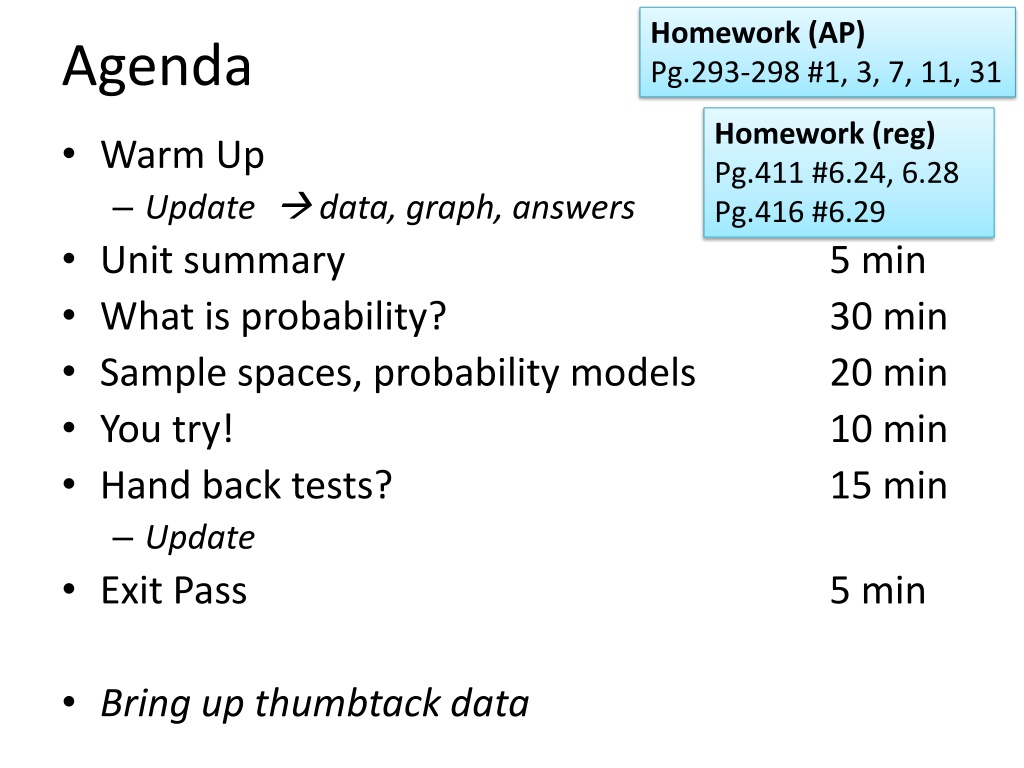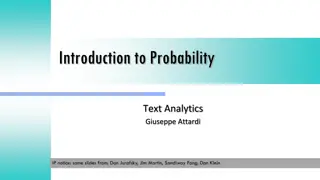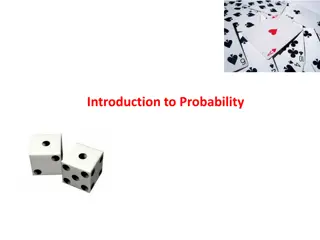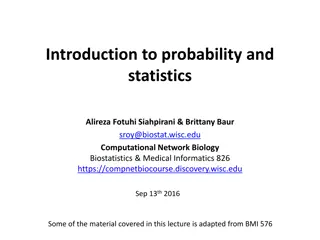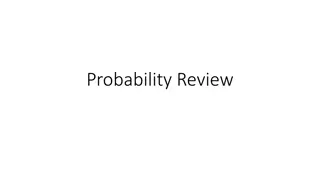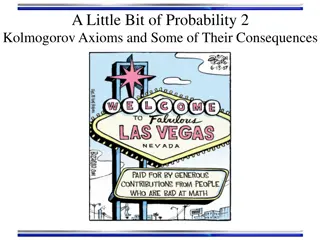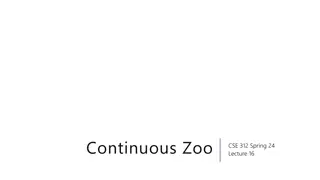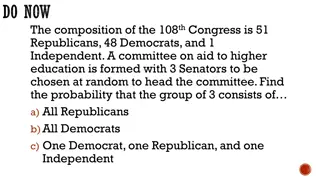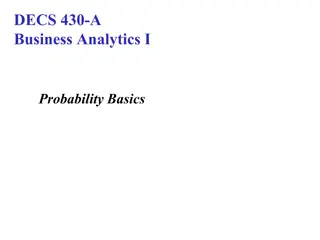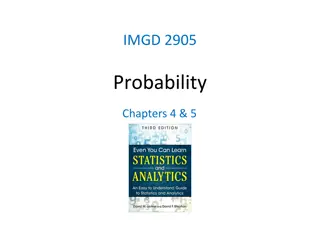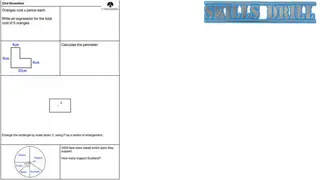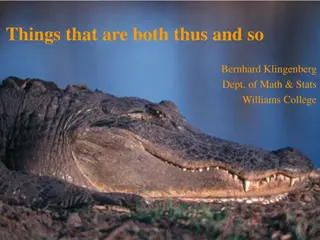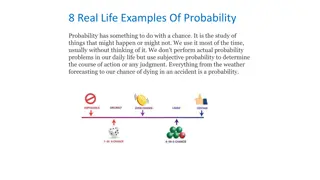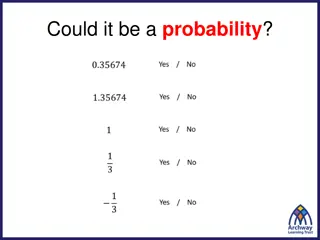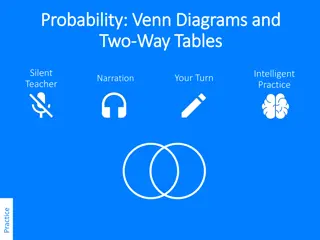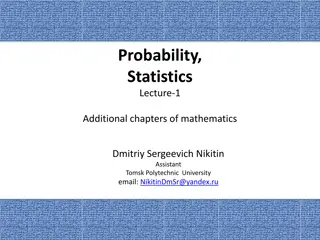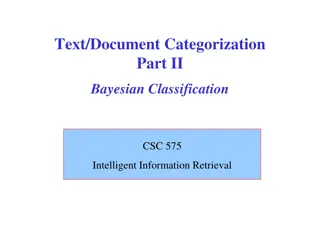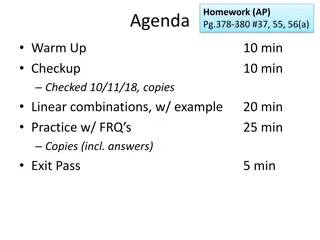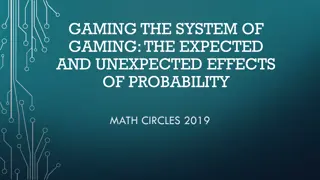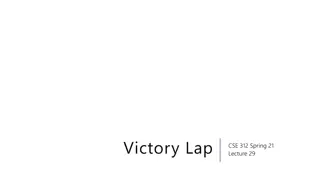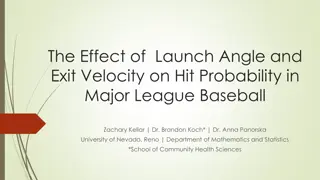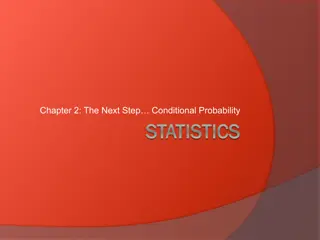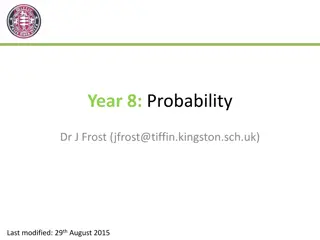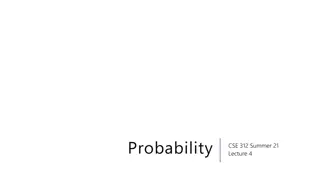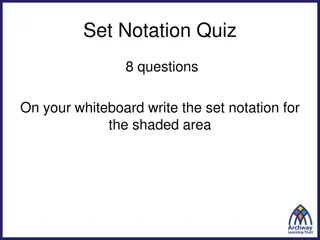Probability Assessment and Warm-Up Analysis
Explore probability assessment results from students' ratings, analyze distributions, calculate z-scores, and determine probabilities. Understand student perceptions of probability knowledge based on their responses. Engage in warm-up activities and solve riddles to test understanding in a fun way.
Download Presentation

Please find below an Image/Link to download the presentation.
The content on the website is provided AS IS for your information and personal use only. It may not be sold, licensed, or shared on other websites without obtaining consent from the author. Download presentation by click this link. If you encounter any issues during the download, it is possible that the publisher has removed the file from their server.
E N D
Presentation Transcript
Homework (AP) Pg.293-298 #1, 3, 7, 11, 31 Agenda Homework (reg) Pg.411 #6.24, 6.28 Pg.416 #6.29 Warm Up Update data, graph, answers Unit summary What is probability? Sample spaces, probability models You try! Hand back tests? Update Exit Pass 10 min 5 min 30 min 20 min 10 min 15 min 5 min Bring up thumbtack data
n=23 Warm Up, P.1 I asked you to rate how well they remember Probability from past math classes. These are your responses. 10 9 8 8 7.85 7 7 7 7 6 6 6 1. Comment on the distribution. 5 5 4 4 4 4 3 3 3 2 2 2. What is the z-score associated with the student who wrote down 7.85 ? 3. What is the probability that a randomly selected Statistics student states a rating higher than this student s rating?
Warm Up, P.1 ANSWERS 1. Slightly skewed right with no apparent outliers, according to the 1.5xIQR rule. The center is a median of 6, with an interquartile range of 3. Most Period 1 students feel somewhat (but not very) sure in their knowledge of Probability. 2. (7.85 5.56)/2.27 = 1.01 3. 1 0.8438 = 0.1562. There is a 15.62% probability that someone states higher than this rating.
7 7 6 6 5 5 5 5 4 4 4 4 3 3 3 Warm Up, P.3 I asked you to rate how well they remember Probability from past math classes. These are your responses. n=30 3 3 3 1. Comment on the distribution. 2.020202 2 2 2 2 2 2 2 2 2 2 2 2. What is the z-score associated with the students who wrote down 2.020202 ? 3. What is the probability that a randomly selected Statistics student states a rating lower than this student s rating?
Warm Up, P.3 ANSWERS 1. Skewed right with no apparent outliers. The center is a median of 3, with an interquartile range of 3. Most Period 3 students feel quite nervous about Probability. 4.32 1.00 19 2. (2.020202 3.4673)/1.6125 = -0.90 3. There is a 18.41% probability that someone states lower than this rating.
1. You answer me, although I never ask you questions. What am I? A telephone 2. What word is always pronounced wrong? Wrong 3. There is 10 birds on a branch. A man shoots 5 of them. How many birds are left on the branch? None. The rest flew away. 4. The one who has it does not keep it. It can be both large and small. It can be any shape. What is it? A gift. A needle. Or a storm. 5. I have one eye but cannot see. What am I? 6. I am outside a shop. I can t read the signs but I know I need to go in to make a purchase. What store am I at? An eye-glasses store. 7. What belongs to you, but other people use it more than you? Your name. 8. I have cities, but no houses. I have mountains, but no trees. I have oceans, but no fishes. What am I? A map.
Unit 5 Probability Defining probability Independent vs. dependent events Basic probability rules, union and intersection Conditional probability
Why probability is awesome Established by gambling mathematicians Pascal and Fernat in 1600s to win dice games Used to predict: Blackjack, Texas Hold Em When people will die (actuary tables) Flow of traffic on highways, phone signals, or computer processors Genetic makeup of people before they re born Spread of epidemic viruses (e.g. zombies) Stocks, economies, price of Big Macs . Behavior of stars and black holes
Window/Door 1. If you flip a coin, what is the probability that you will get heads ? 2. Flip a coin twice. How many heads do you expect? 3. Flip a coin 24,000 times. How many heads do you expect? 4. Would it surprise you to get all Heads in #2? 5. Would it surprise you to get all Heads in #3?
Tossing Thumbtacks Toss a thumbtack four times. I ll ask you for the number of point ups . *show graph of class data* Window/Door: 1. Does the proportion of successes fluctuate more at the beginning or at the end of this process? Why do you think that is? 2. Does the cumulative proportion appear to be settling down around one particular value? What do you think that value will be? 3. If you toss your thumbtack 10 times tomorrow, how many times do you think it will land with its point facing up? 4. If you toss your thumbtack 1000 times tomorrow, how many times do you think it will land with its point facing up? 5. If you roll a 6-sided die 600 times, how many times do you think you ll roll 1 ? 6. What does it mean that the probability of rolling a 1 on a 6-sided die is 1/6? 0.8 0.7 Cumulative Probability 0.6 0.5 0.4 0.3 0.2 0.1 0 0 50 100 150 200 250
Reality is unpredictable in the short run.. but has a predictable pattern in the long run.
Notes Probability Important Ideas 1 of 2 Probability fraction (or proportion, or percentage) of successes in a very long series of repetitions. Sample space = set of all possible outcomes (or events ) Probability model/table = sample space, corresponding probabilities of each outcome in sample space. If all outcomes are equally likely: # possible successes # possible outcomes
Notes 2 of 2 Example Flipping a coin three times Sample space HHH TTT HTT THT TTH HHT HTH THH Probability table for X = number of heads X 3 2 1 0 P(X)
You try! (whiteboards) Above door sample space for rolling two standard 6-sided die. 1. Create a probability model for X = SUM of the two die. Sum(X) Sum(X) 2 3 4 5 P(X) P(X) /36 /36 /36 /36 P(X) 1/36 4/36 6 6 6 7 7 7 8 8 8 9 9 9 10 10 10 11 11 11 12 12 12 Sum(X) Sum(X) 2 2 3 3 4 4 5 5 /36 5/36 /36 6/36 /36 5/36 /36 4/36 /36 3/36 /36 2/36 /36 1/36 2/36 3/36 P(X)
Door/Window What is the sample space, AND are all the outcomes equally likely? 1. 2. 3. 4. 5. 6. 7. Whether or not a fair die lands on 1,2,3,4,5,6 Sum of two fair dice being 2,3,4,5,6,7,8,9,10,11,12 Coin landing heads or tails when flipped Coin landing heads or tails when spun on its side Tennis racquet landing with label up or down when spun on its end Your grade in this course being A, B, C, D, or F Whether or not California experiences a catastrophic earthquake in the next year Whether or not your server brings you the correct meal you ordered Whether or not there is intelligent life on Mars 10. Whether or not a woman will be elected president in 2020 11. Whether or not a woman will be elected president before 2100 12. A Reese s Pieces candy selected randomly is orange, yellow, or brown 8. 9.
Whiteboards A standard card deck has 52 cards. There are four suits ..diamonds (red), hearts (red), clubs (black), and spades (black). There are 13 cards in each suit ..2-10, then the face cards Jack, Queen, and King. Lastly, there is an Ace. What is the probability of drawing .. 1. ..the Ace of Spades? 2. ..any Heart? 3. ..any red card? 4. ..a 2 or a 3? 5. ..a face card? Challenge: 6. ..a Jack or a Heart? 7. ..a pair of Aces?
Unit 4 Test Data Collection Last Friday s tests
80.00% 70.00% 60.00% 50.00% 40.00% 30.00% 20.00% 10.00% 0.00% P.1 P.3
Unit 4 test: Common mistakes, 1 of 3 A company wishes to find out whether students at a university prefers brand A or brand B of instant coffee. A random sample of students is selected, and each student is asked first to try brand A and then to try brand B, or vice versa (with the order determined at random). They then indicate which brand they prefer. This is an example of A. a matched-pair design. B. an observational study, not an experiment. C. a stratified sampling design. D. a survey E. a systematic sampling design. 9. Twelve people who suffer from chronic fatigue syndrome volunteer to take part in an experiment to see if shark fin extract will increase one s energy level. Half of the volunteers are to be given shark fin extract twice a day and the other half a placebo twice a day. We decide to use a block design with the men forming one block and the women the other. A block design is appropriate if A. An equal number of men and women suffer from low energy level. B. Gender equity is an important legal consideration. C. We believe men and women will respond differently to treatments. D. We have already stratified, and want to be even more precise with our assignment of treatments. E. All of the above. 3.
Unit 4 test: Common mistakes, 2 of 3 11. In a recent study, a random sample of children in grades 2 through 4 showed a significant negative relationship between amount of homework assigned and student attitudes. This must be an example of A. An experiment. B. The establishing of one variable causing a change in another variable through correlation. C. An observational study. D. A block design, with grades as blocks. E. A cause-and-effect relationship. 14. Suppose volunteers were first divided into groups of men and women, and then half of the men were randomly assigned to the new drug and half of the women to the new drug. The remaining volunteers received the other drug. This would be an example of A. Replication. B. Confounding. The effects of gender will be mixed up with the effects of the drug. C. A double-blind experiment. D. A block design. E. An observational study.
Unit 4 test: Common mistakes, 3 of 3 Because of concerns about employee stress, a large company is conducting a study to compare two programs (Tai Chi or Yoga) that may help employees reduce their stress levels. The company has assembled a group of volunteer employees to participate in the study during the first half of their lunch hour each day for a 10-week period. Each volunteer will be assigned at random to one of the two programs. Volunteers will have their stress levels measured just before beginning the program and 10 weeks later at the completion of the program. 17. (c)If, at the conclusion of the study, volunteers who participated in the Tai Chi program had significantly lower stress levels than the control group, could you reasonably conclude that Tai Chi decreases stress levels? Why or why not?
Homework (AP) Pg.293-298 #1, 3, 7, 11, 31 Exit Pass 1. What does it mean to say The probability of getting a pair of Aces is 0.45% ? 2. What is the probability of rolling a 10-sided die and getting a 2 or a 3? 3. What is the probability of flipping a coin twice and getting 2 Heads?
